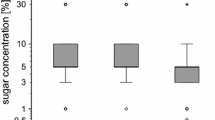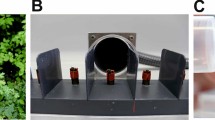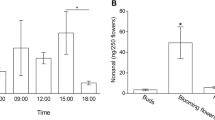Abstract
Honey bees of Apis mellifera could be trained to be highly reliable sniffers for the detection of Andrographis paniculata using the classical Pavlovian conditioning training method with high success rate, > 80% based on the proboscis extension reflex as a positive response to the presence of the herb. The success rate of sniffer bees was found to be in a temperature dependent manner, but not significantly affected by the heating duration (5–110 min). The variance of 7.7% success rate was observed for the heating temperature ranged 50–120 °C with the highest success rate (92.7%) at 100 °C. This could be due to the content of signature compounds released from the heated herbal samples. Three signature compounds such as dihydroactinidiolide, apiol and 6,10,14-trimethyl-2-pentadecanone were proposed to be the volatile marker of the herb since their concentrations changed in accordance with the temperature profile and success rate of sniffer bees. The volatile compounds were extracted by divinylbenzene and carboxen coated polydimethylsiloxane fiber in the headspace of solid phase micro-extraction before analyzed by GC–MS for identification. Almost 50% success rate could be achieved using the minimum amount of 20 mg herbal samples. High selectivity of the sniffer bees has also been proven by no response to another morphologically similar herb, Clinacanthus nutans which was also heat-treated in the similar manner. The sniffer bees also showed to exhibit 80% success rate to detect A. paniculata mixed with 50% C. nutans as interference in a mixture.





Similar content being viewed by others
References
Layton, J. (2017). How can you train honeybees to sniff for bombs? http://science.howstuffworks.com/bomb-sniffing-bees.htm. Accessed May 9 2017.
Bromenshenk, J., Henderson, C., Seccomb, R., Rice, S., Etter, R., Bender, S., et al. (2016). Can honey bees assist in area reduction and landmine detection? Journal of Conventional Weapons Destruction, 7, 24–27.
Rodacy, P. J., Bender, S., Bromenshenk, J., Henderson, C., & Bender, G. (2002). Training and deployment of honeybees to detect explosives and other agents of harm. In Proceedings Society of Photo-Optical Instrumentation Engineers, 4742, Detection and Remediation Technologies for Mines and Minelike Targets VII, (13 August 2002) (pp. 474–481).
Suckling, D. M., & Sagar, R. L. (2011). Honeybees Apis mellifera can detect the scent of Mycobacterium tuberculosis. Tuberculosis, 91, 327–328.
Chamberlain, K., Briens, M., Jacobs, J. H., Clark, S. J., & Pickett, J. A. (2012). Use of honey bees (Apis mellifera L.) to detect the presence of Mediterranean fruit fly (Ceratitis capitata Wiedemann) larvae in Valencia oranges. Journal of the Science of Food and Agriculture, 92, 2050–2054.
Galizia, C. G., & Menzel, R. (2011). The role of glomeruli in the neural representation of odours: Results from optical recording studies. Journal of Insect Physiology, 47, 115–130.
Akbar, S. (2011). Andrographis paniculata: A review of pharmacological activities and clinical effects. Alternative Medicine Review, 16, 66–77.
Mishra, U., Mishra, A., Kumari, R., Murthy, P., & Naik, B. (2009). Antibacterial activity of ethanol extract of Andrographis paniculata. Indian Journal of Pharmaceutical Science, 71, 436.
Sule, A., Ahmed, Q. U., Latip, J., Samah, O. A., Omar, M. N., Umar, A., et al. (2012). Antifungal activity of Andrographis paniculata extracts and active principles against skin pathogenic fungal strains in vitro. Pharmaceutical Biology, 50, 850–856.
Wiart, C., Kumar, K., Yusof, M., Hamimah, H., Fauzi, Z., & Sulaiman, M. (2005). Antiviral properties of ent-labdene diterpenes of Andrographis paniculata nees, inhibitors of herpes simplex virus type 1. Phytotheraphy Research, 19, 1069–1070.
Kapil, A., Koul, I., Banerjee, S., & Gupta, B. (1993). Antihepatotoxic effects of major diterpenoid constituents of Andrographis paniculata. Biochemical Pharmacology, 46, 182–185.
Hossain, M. A., Roy, B., Ahmed, K., Chowdhury, A. S., & Rashid, M. (2007). Antidiabetic activity of Andrographis paniculata. Dhaka University Journal of Pharmaceutical Science, 6, 15–20.
Bhatnagar, S., Santapau, H., Desa, J., Maniar, A., Ghadially, N., Solomon, M., et al. (1961). Biological activity of Indian medicinal plants, Part I. Antibacterial, anti-tubercular and antifungal action. Indian Journal of Medical Research, 49, 799–813.
Thakur, A. K., Chatterjee, S. S., & Kumar, V. (2015). Adaptogenic potential of andrographolide: An active principle of the king of bitters (Andrographis paniculata). Journal of Traditional and Complementary Medicine, 5, 42–50.
Lazarowych, N. J., & Pekos, P. (1998). Use of fingerprinting and marker compounds for identification and standardization of botanical drugs: Strategies for applying pharmaceutical HPLC analysis to herbal products. Drug Information Journal, 32, 497–512.
Sasidharan, S., Chen, Y., Saravanan, D., Sundram, K., & Latha, L. Y. (2011). Extraction, isolation and characterization of bioactive compounds from plants’ extracts. African Journal of Traditional, Complementary and Alternative Medicines, 8, 1–10.
Wagner, H., & Bladt, S. (1996). Plant drug analysis: A thin layer chromatography atlas. Berlin: Springer.
Chen, Y. R., Wen, K. C., & Her, G. R. (2000). Analysis of coptisine, berberine and palmatine in adulterated Chinese medicine by capillary electrophoresis–electrospray ion trap mass spectrometry. Journal of Chromatography A, 866, 273–280.
Logan, B. K., Reinhold, L. E., Xu, A., & Diamond, F. X. (2012). Identification of synthetic cannabinoids in herbal incense blends in the United States. Journal of Forensic Science, 57, 1168–1180.
Zhang, Z., Yang, M. J., & Pawliszyn, J. (1994). Solid-phase microextraction. A solvent-free alternative for sample preparation. Analytical Chemistry, 66, 844A–853A.
Vas, G., & Vekey, K. (2004). Solid-phase microextraction: A powerful sample preparation tool prior to mass spectrometric analysis. Journal of Mass Spectrometry, 39, 233–254.
Mott, M. (2004). Bees, aiant African rats used to sniff landmines. National Geographic News 10.
Menzel, R. (1999). Memory dynamics in the honeybee. Journal of Comparative Physiology. A, Neuroethology, Sensory, Neural, and Behavioral Physiology, 185, 323–340.
Calogirou, A., Larsen, B., & Kotzias, D. (1999). Gas-phase terpene oxidation products: A review. Atmospheric Environment, 33, 1423–1439.
Dudareva, N., Pichersky, E., & Gershenzon, J. (2004). Biochemistry of plant volatiles. Plant Physiology, 135, 1893–1902.
Cheng, A. X., Lou, Y. G., Mao, Y. B., Lu, S., Wang, L. J., & Chen, X. Y. (2007). Plant terpenoids: Biosynthesis and ecological functions. Journal of Integrative Plant Biology, 49, 179–186.
Knudsen, J. T., Eriksson, R., Gershenzon, J., & Stahl, B. (2006). Diversity and distribution of floral scent. The Botanical Review, 72, 1–120.
Cowan, M. M. (1999). Plant products as antimicrobial agents. Clinical Microbiology Review, 12, 564–582.
Huang, M., Sanchez-Moreiras, A. M., Abel, C., Sohrabi, R., Lee, S., Gershenzon, J., et al. (2012). The major volatile organic compound emitted from Arabidopsis thaliana flowers, the sesquiterpene (E)-β-caryophyllene, is a defense against a bacterial pathogen. New Phytologist, 193, 997–1008.
Hiltpold, I., Erb, M., Robert, C. A. M., & Turlings, T. C. J. (2011). Systemic root signalling in a belowground, volatile-mediated tritrophic interaction. Plant, Cell and Environment, 34, 1267–1275.
Ghelardini, C., Galeotti, N., Di Cesare Mannelli, L., Mazzanti, G., & Bartolini, A. (2001). Local anaesthetic activity of β-caryophyllene. II Farmaco, 56, 387–389.
Burdock, G. A. (2004). Fenaroli’s handbook of flavor ingredients (5th ed.). Boca Raton, FL: CRC Press.
Palaniswamy, U. R. (2005). Effect of light intensity on the pigment composition and oxalic acid concentrations in Kalamegh (Andrographis paniculata) leaf (pp. 109–114). International Society for Horticultural Science (ISHS), Leuven, Belgium.
Whiton, R. S., & Zoecklein, B. W. (2000). Optimization of headspace solid-phase microextraction for analysis of wine aroma compounds. American Journal of Enology and Viticulture, 51, 379–382.
Rocha, S., Martins, V. M. R., Barros, A., Delgadillo, I., & Coimbra, M. A. (2001). Headspace solid phase microextraction (SPME) analysis of flavor compounds in wines. Effect of the matrix volatile composition in the relative response factors in a wine model. Journal of Agricultural and Food Chemistry, 49, 5142–5151.
Kolb, B., & Ettre, L. S. (2006). Static headspace-gas chromatography: Theory and practice. Hoboken, NJ: Wiley.
Acknowledgements
The authors would like to thank Universiti Teknologi Malaysia for the financial support from the research Grants 4H45 and 14H24.
Author information
Authors and Affiliations
Corresponding author
Rights and permissions
About this article
Cite this article
Kerk, W.C., Chua, L.S., Sarmidi, M.R. et al. Sniffer Bees as a Reliable Tool for Andrographis paniculata Detection. Sens Imaging 19, 9 (2018). https://doi.org/10.1007/s11220-018-0194-y
Received:
Revised:
Published:
DOI: https://doi.org/10.1007/s11220-018-0194-y




